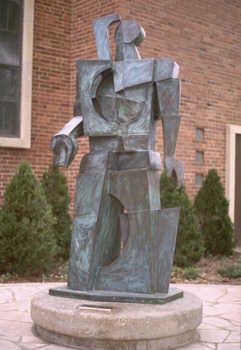Forgiven Man
As reported by Phil Anderson of the Topeka Capital-Journal, February 7, 2020:
Over six decades, sculptor Jim Bass lent his artistic talents to dozens of art projects that continue to bear his unique mark across Topeka and the Midwest.The thieves had the right idea; Forgiven Man looks like scrap metal already, and as far as this blogger is concerned, that would have been a better use for the sculpture. Its absence from its pedestal was an example of what Branch Rickey called "addition by subtraction."
Several of his bronze sculptures stand today at Topeka houses of worship, serving as a lasting legacy for Bass, who died Jan. 10 at his Topeka home at the age of 86.
A celebration of his life will be held at 2 p.m. Saturday, Feb. 15, at First Congregational United Church of Christ, 1701 S.W. Collins Ave., where Bass was a longtime member.
Among Bass’ most prominent pieces of art is a sculpture titled “Forgiven Man,” which stands in the Helen Mettner Courtyard on the southeast side of First Congregational Church, where it was installed in 1986.
Sculptures standing 10 feet tall and weighing more than 350 pounds usually don’t move. But “Forgiven Man” proved to be an exception.
The sculpture was gone for a few months after it was stolen on Oct. 3, 2012. Authorities said at the time that thieves unbolted the sculpture from its pedestal, then moved it to a waiting truck.
Church officials at the time said they believed the thieves had planned to cut it up and sell it for scrap metal. With bronze fetching about 80 cents a pound at the time, Bass surmised the scrap metal would only bring about $300. The sculpture, meanwhile, was valued around $40,000.
Soon after the sculpture was stolen, Bass met with church leaders to try to devise a way to get it back. A $2,000 reward was offered.
A few days later, someone came forward and gave church officials information leading to the sculpture’s discovery on Oct. 11, 2012, in the 7600 block of S.E. Croco Road. The $2,000 reward was paid, no questions asked, and the sculpture was stored for a few months until it could be repaired, then reinstalled.
This time, “Forgiven Man” was welded into place on May 10, 2013, after several men moved the sculpture from the back of a truck to its original location in the Mettner Courtyard.
“It’s on for good,” Bass said that day, looking at “Forgiven Man” as it was standing tall once again atop its pedestal. “Even we won’t be able to get it off.”
Considering all it had been through, “Forgiven Man” was in remarkably good shape, with only a few nicks.
As was typical of Bass, he saw something good in the ordeal, noting there was some significance in “Forgiven Man” being lost but later found.
″ ‘Forgiven Man’ had a little scar on the back of one of his legs,” the Rev. Tobias Schlingensiepen, First Congregational Church’s pastor, said recently. “But like Jim said, ‘Forgiven Man’ should have some scars.”
The sculpture stands as a silent testament to God’s grace and forgiveness to everyone, including those who stole it, Schlingensiepen said the day it was reinstalled.
In late 2019, about three months before he died, Bass presented First Congregational Church with five smaller sculptures that have been placed at various locations inside the church.
“He knew his end was coming,” Schlingensiepen said. “He wanted the church to have them...”
...One of his bronze sculptures, “Sword & Plowshare,” is on the south side of Temple Beth Sholom, Topeka’s Jewish congregation at 4200 S.W. Munson.
Bass also made sculptures for First United Methodist Church, 600 S.W. Topeka Blvd., and for Nebraska Wesleyan University in Lincoln, Neb.
He is survived by his partner, Connie Mills, and children Jaminda Bass Holmes and Joren Bass, along with three grandchildren.






































No comments:
Post a Comment